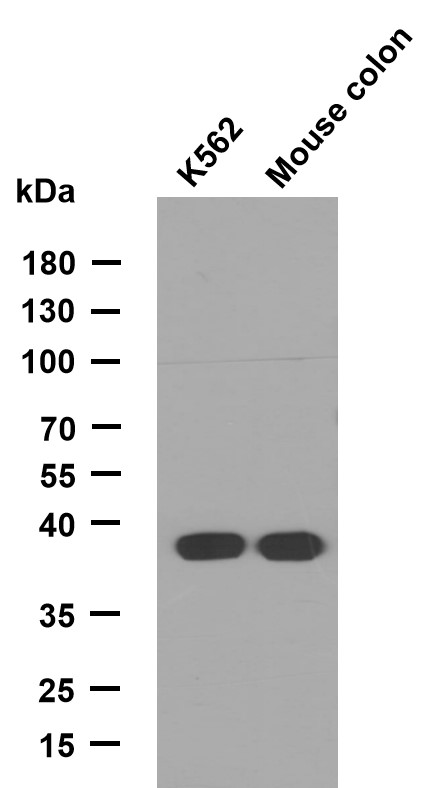Lyn (Phospho Tyr507) rabbit pAb
- Catalog No.:YP1389
- Applications:WB
- Reactivity:Human;Mouse
- Target:
- Lyn
- Fields:
- >>Chemokine signaling pathway;>>NF-kappa B signaling pathway;>>Platelet activation;>>B cell receptor signaling pathway;>>Fc epsilon RI signaling pathway;>>Fc gamma R-mediated phagocytosis;>>Long-term depression;>>Epithelial cell signaling in Helicobacter pylori infection;>>Kaposi sarcoma-associated herpesvirus infection;>>Epstein-Barr virus infection;>>Viral carcinogenesis;>>Lipid and atherosclerosis
- Gene Name:
- LYN JTK8
- Protein Name:
- Lyn (Tyr507)
- Human Gene Id:
- 4067
- Human Swiss Prot No:
- P07948
- Mouse Gene Id:
- 17096
- Mouse Swiss Prot No:
- P25911
- Rat Gene Id:
- 81515
- Rat Swiss Prot No:
- Q07014
- Immunogen:
- Synthesized phosho peptide around human Lyn (Tyr507)
- Specificity:
- This antibody detects endogenous levels of Human Mouse Lyn (phospho-Tyr507)
- Formulation:
- Liquid in PBS containing 50% glycerol, 0.5% BSA and 0.02% sodium azide.
- Source:
- Polyclonal, Rabbit,IgG
- Dilution:
- WB 1:1000-2000
- Purification:
- The antibody was affinity-purified from rabbit serum by affinity-chromatography using specific immunogen.
- Concentration:
- 1 mg/ml
- Storage Stability:
- -15°C to -25°C/1 year(Do not lower than -25°C)
- Other Name:
- Tyrosine-protein kinase Lyn (EC 2.7.10.2) (Lck/Yes-related novel protein tyrosine kinase) (V-yes-1 Yamaguchi sarcoma viral related oncogene homolog) (p53Lyn) (p56Lyn)
- Observed Band(KD):
- 58kD
- Background:
- This gene encodes a tyrosine protein kinase, which maybe involved in the regulation of mast cell degranulation, and erythroid differentiation. Alternatively spliced transcript variants encoding different isoforms have been found for this gene. [provided by RefSeq, Jul 2011],
- Function:
- catalytic activity:ATP + a [protein]-L-tyrosine = ADP + a [protein]-L-tyrosine phosphate.,similarity:Belongs to the protein kinase superfamily. Tyr protein kinase family.,similarity:Belongs to the protein kinase superfamily. Tyr protein kinase family. SRC subfamily.,similarity:Contains 1 protein kinase domain.,similarity:Contains 1 SH2 domain.,similarity:Contains 1 SH3 domain.,subunit:Interacts with phosphorylated LIME1 and with CD79A upon BCR activation. Interacts with Epstein-Barr virus LMP2A. Interacts with TGFB1I1. Interaction, via the SH2 and SH3, domains with MUC1 is stimulated by IL7 and, the subsequent phosphorylation increases the binding between MUC1 and CTNNB1/beta-catenin. Interacts with PPP1R15A via the SH3 domain.,tissue specificity:Expressed in primary neuroblastoma tumors.,
- Subcellular Location:
- Cell membrane. Nucleus. Cytoplasm. Cytoplasm, perinuclear region. Golgi apparatus. Membrane ; Lipid-anchor . Accumulates in the nucleus by inhibition of CRM1-mediated nuclear export. Nuclear accumulation is increased by inhibition of its kinase activity. The trafficking from the Golgi apparatus to the plasma membrane occurs in a kinase domain-dependent but kinase activity independent manner and is mediated by exocytic vesicular transport. Detected on plasma membrane lipid rafts.
- Expression:
- Detected in monocytes (at protein level). Detected in placenta, and in fetal brain, lung, liver and kidney. Widely expressed in a variety of organs, tissues, and cell types such as epidermoid, hematopoietic, and neuronal cells. Expressed in primary neuroblastoma tumors.
- June 19-2018
- WESTERN IMMUNOBLOTTING PROTOCOL
- June 19-2018
- IMMUNOHISTOCHEMISTRY-PARAFFIN PROTOCOL
- June 19-2018
- IMMUNOFLUORESCENCE PROTOCOL
- September 08-2020
- FLOW-CYTOMEYRT-PROTOCOL
- May 20-2022
- Cell-Based ELISA│解您多样本WB检测之困扰
- July 13-2018
- CELL-BASED-ELISA-PROTOCOL-FOR-ACETYL-PROTEIN
- July 13-2018
- CELL-BASED-ELISA-PROTOCOL-FOR-PHOSPHO-PROTEIN
- July 13-2018
- Antibody-FAQs



